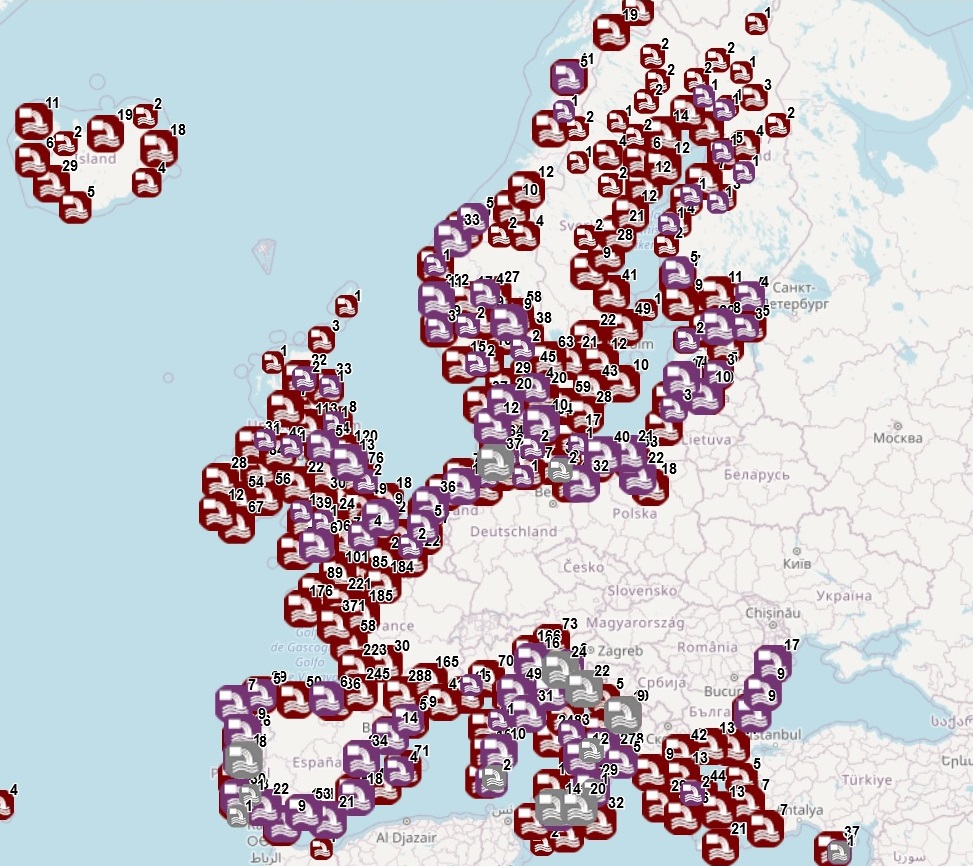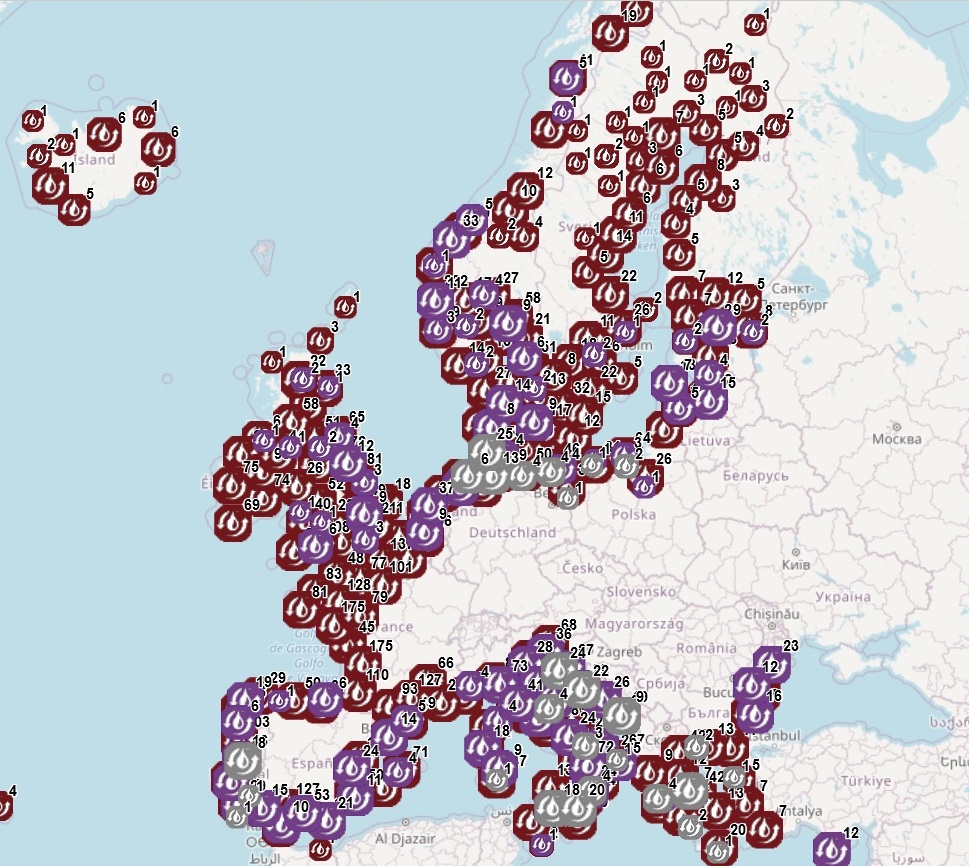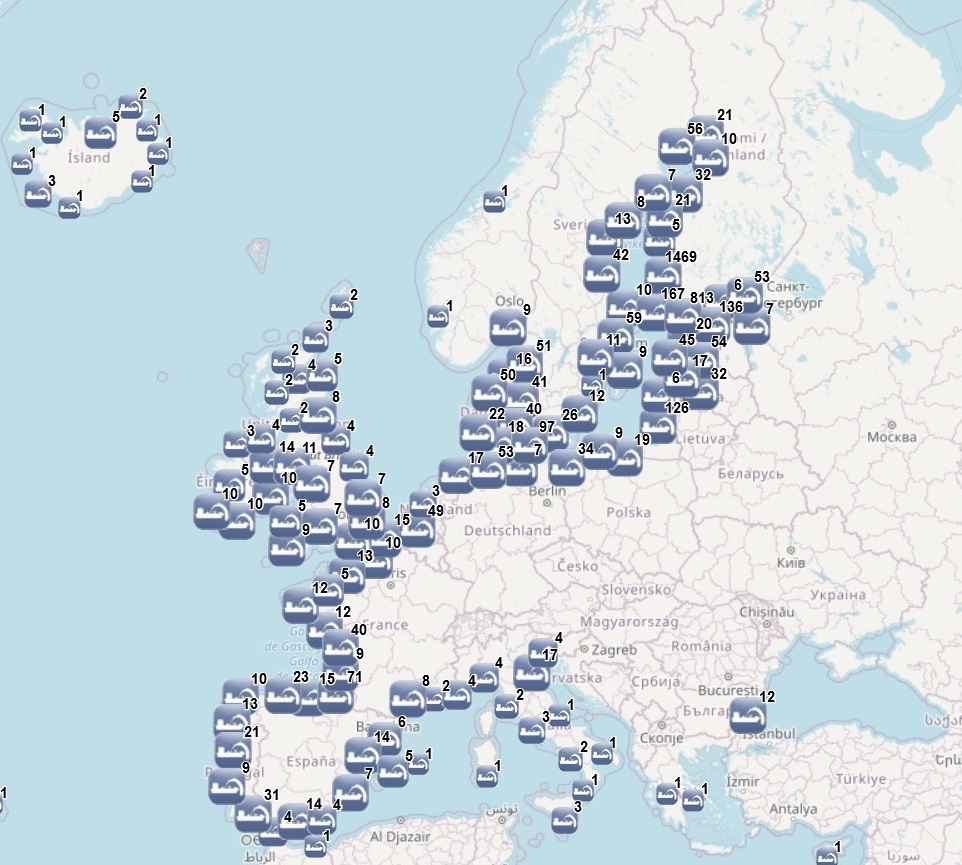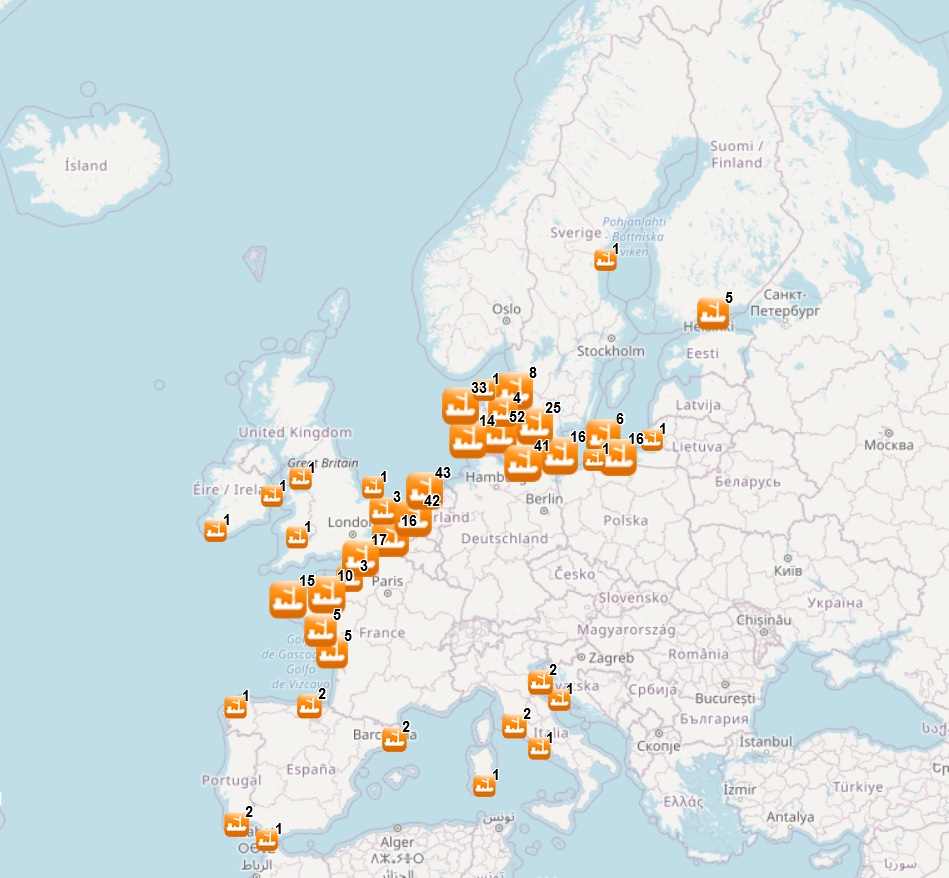AZTI
Type of resources
Available actions
Topics
Keywords
Contact for the resource
Provided by
Years
Formats
Representation types
-

The dataset on ocean energy in the European seas was created in 2014 by AZTI for the European Marine Observation and Data Network (EMODnet). It is the result of the aggregation and harmonization of datasets provided by several sources from all across the European countries. It is updated every year, and is available for viewing and download on EMODnet web portal (Human Activities, https://emodnet.ec.europa.eu/en/human-activities). The dataset contains points representing Ocean Energy project sites in the following countries: Belgium, Denmark, Finland, France, Ireland, Italy, Norway, Portugal, Russia, Spain, Sweden, The Netherlands and United Kingdom. Where available, each point has the following attributes: site code (ID_1), project code (ID), name, location, country, sea basin, sea, distance to coast (metres), resource type (wave, tidal, salinity gradient, wave/wind), starting year, ending year, lease status, technology (Based on www.aquaret.com/), device, device scale (Full scale, prototype, etc.), project scale (Commercial, Demonstrator Array, etc.), project status (operational, completed, etc.), project capacity (KW), promoter, position info (it indicates if the attribute value is original from the source or has been estimated or calculated the polygon centroid) and the studies conducted for the environmental assessment (EIA). In 2016, a feature on areas for ocean energy test sites was included. It contains polygons representing Ocean Energy test sites in the following countries: Denmark, France, Ireland, Norway, Portugal, Spain, Sweden, The Netherlands and United Kingdom. Where available, each polygon has the following attributes: test site code, name, location, country, sea basin, sea, distance to coast (metres), resource type (wave, tidal), starting year, ending year, lease status, site status, capacity (kW), depth (metres), area (square km), grid connection, number of berths, developer, position info (it indicates if the attribute value is original from the source or has been estimated) and the studies conducted for the Environmental Assessment (EIA). In 2024, new data has been included and existing data has been updated.
-

The dataset on coastal discharge points from Urban Waste Water Treatment Plant (UWWTP) was created in 2019 by AZTI for the European Marine Observation and Data Network (EMODnet). It is based on the dataset "Waterbase-UWWTD" (Urban Waste Water Treatment Directive – reported data) provided by the European Topic Centre on Inland, Coastal and Marine waters, and made available at https://www.eea.europa.eu/data-and-maps/data/waterbase-uwwtd-urban-waste-water-treatment-directive-8. The dataset is available for viewing and download on EMODnet web portal (Human Activities, https://emodnet.ec.europa.eu/en/human-activities) and it presents the available information (location of discharge points, link to specific treatment plant, type of receiving area into which the effluent/wastewater is discharged, related waterbody/river basin) on individual points of discharge from treatment plants or collecting systems located in coastal NUTS3 regions, based on data selected from the reporting of Member States as part of the UWWTD implementation. The geographic coverage is: Belgium, Bulgaria, Croatia, Cyprus, Denmark, Estonia, Finland, France, Germany, Greece, Iceland, Ireland, Italy, Latvia, Lithuania, Malta, Netherlands, Norway, Poland, Portugal, Romania, Slovenia, Spain, Sweden, United Kingdom. The description of all attribute fields of UWWTP is given in the Waterbase-UWWTD (https://www.eea.europa.eu/data-and-maps/data/waterbase-uwwtd-urban-waste-water-treatment-directive-8/waterbase-uwwtd). In this update, data provided by several countries during 2022 (Waterbase reported under UWWTD data call 2021; version 10 publised 15 January 2023) are included.
-

The datset on coastal Urban Waste Water Treatment Plant (UWWTP) was created in 2019 by AZTI for the European Marine Observation and Data Network (EMODnet). It is based on the dataset "Waterbase-UWWTD" (Urban Waste Water Treatment Directive – reported data) provided by the European Topic Centre on Inland, Coastal and Marine waters, and made available at https://www.eea.europa.eu/en/datahub/datahubitem-view/6244937d-1c2c-47f5-bdf1-33ca01ff1715. The datset is available for viewing and download on EMODnet - Human Activities web portal (https://emodnet.ec.europa.eu/en/human-activities). Based on data selected from the reporting of Member States as part of the UWWTD implementation, the dataset presents the available information (location, capacity and actual load treated, type of treatment, aggregated data on the performance of plants) on individual UWWTP, and collecting systems without UWWTP, located in NUTS3 regions bordering transitional, coastal and marine waters. The geographic coverage is: Belgium, Bulgaria, Croatia, Cyprus, Denmark, Estonia, Finland, France, Germany, Greece, Iceland, Ireland, Italy, Latvia, Lithuania, Malta, Netherlands, Norway, Poland, Portugal, Romania, Slovenia, Spain, Sweden, United Kingdom. The description of all attribute fields of UWWTP is given in the Waterbase-UWWTD (https://www.eea.europa.eu/en/datahub/datahubitem-view/6244937d-1c2c-47f5-bdf1-33ca01ff1715). In this update, data provided by several countries during 2022 (Waterbase reported under UWWTD data call 2021; version 10 publised 15 January 2023) are included.
-

The dataset on dredging in the European seas was created in 2014 by AZTI for the European Marine Observation and Data Network (EMODnet) and it is the result of the aggregation and harmonization of data provided by several sources from all across the Europe. It is available for viewing and download on EMODnet web portal (Human Activities, https://emodnet.ec.europa.eu/en/human-activities). The dataset contains points representing dredging sites in the following countries: Belgium, Bulgaria, Cyprus, Denmark, Estonia, Finland, France, Germany, Greece, Iceland, Ireland, Italy, Latvia, Lithuania, Malta, Norway, Poland, Portugal, Spain, Sweden, The Netherlands and United Kingdom. Where available, each point has the following attributes: Id (Identifier), Position Information (e.g.: Estimated, Original, Polygon centroid of dredging area, Polygon centroid of dredging polygon), Country, Sea basin, Sea, Extraction Area, Year (when data is for a time period, the first year of the period is indicated), Permitted Amount (m3), Permitted Amount (t), Extracted Amount (m3), Extracted Amount (t), Extraction Type (e.g.: Harbour dredging, Estuary dredging, Sea lane), Purpose (e.g.: Maintenance dredging, Capital dredging, Others), End Use (e.g.: Beach nourishment, Commercialization, Confined deposit, Construction material, Embankment, Filling material, Land deposit, Reuse, Sea disposal, Wetland restoration), Material type (e.g.: silt, sand, gravel), Notes, Link to Web Sources. In the 2024 update, extraction data until 2023 has been included.
-

The dataset on aggregate extractions in the European seas was created in 2014 by AZTI for the European Marine Observation and Data Network (EMODnet). It is the result of the aggregation and harmonization of datasets provided by several sources from all across Europe. It is available for viewing and download on EMODnet web portal (Human Activities, https://emodnet.ec.europa.eu/en/human-activities). The dataset contains points representing aggregate extraction sites, by year (although some data are indicated by a period of years), in the following countries: Belgium, Denmark, Finland, France, Germany, Ireland, Italy, Lithuania, Poland, Portugal, Spain, Sweden, The Netherlands and United Kingdom. Where available, each point has the following attributes: Id (Identifier), Position Info (e.g.: Estimated, Original, Polygon centroid of dredging area, Estimated polygon centroid of dredging area), Country, Sea basin, Sea, Name of the extraction area, Area of activity (km2), Year (the year when the extraction took place; when a time period is available, the first year of the period is indicated), Permitted Amount (m3) (permitted amount of material to be extracted, in m3), Permitted Amount (t) (permitted amount of material to be extracted, in tonnes), Requested Amount (m3) (requested amount of material to be extracted, in m3), Requested Amount (t) (requested amount of material to be extracted, in tonnes), Extracted Amount (m3) (extracted amount of material, in m3), Extracted Amount (t) (extracted amount of material, in tonnes), Extraction Type (Marine sediment extraction), Purpose (e.g.: Commercial, Others, N/A), End Use (e.g.: Beach nourishment, Construction, Reclamation fill, N/A), Material type (e.g.: sand, gravel, maerl), Notes, Link to Web Sources. In 2018, a feature on areas for aggregate extractions was included. It contains polygons representing areas of seabed licensed for exploration or extraction of aggregates, in the following countries: Belgium, Denmark, Estonia, Finland, France, Germany, Italy, Lithuania, Poland, Portugal, Russia, Spain, Sweden, The Netherlands and United Kingdom. Where available, each polygon has the following attributes: Id (Identifier), Area code, Area name, Country, Sea basin, Sea, Starting year (the year when the license starts), End year (the year when the license ends), Site Type (exploration area, extraction area, extraction area (in use)), License status (Active, not active, expired, unknown), Material type (e.g.: sand, gravel, maerl), Notes, Distance to coast (in metres), Link to Web Sources. In the 2024 update, extraction data until 2023 and new areas have been included.
 EMODnet Product Catalogue
EMODnet Product Catalogue